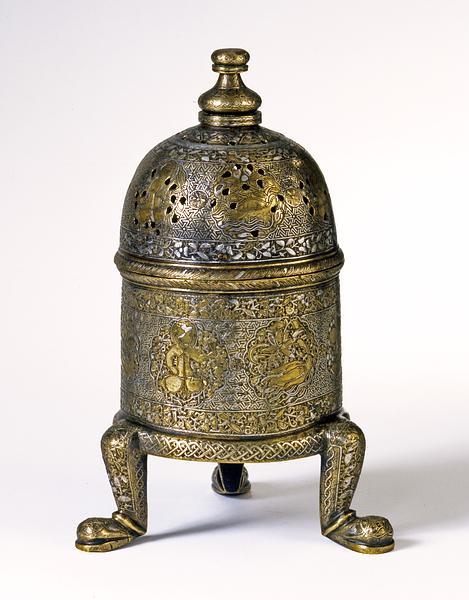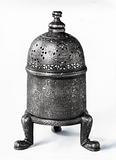Incense burner, cast brass, engraved and inlaid with silver and gold
Northwestern Iran; 1st half of 14th century
H: 21.5 cm
Cylindrical incense burners on three legs and with a domed lid were common from Iraq to Egypt in the 13th and 14th century, but are also known from Iran under the Il-Khanids. All had a horizontal handle and contained a tray for charcoal, both of which are usually missing.
The swastika-like motifs, the clothing of the figures drinking wine and making music, and the birds point to the piece having been made in Mongol Iran. A motif like the tortoise, which is also found on the museum’s tapestry roundel (see
30/1995), moreover had a significance in Chinese, but not in Islamic, art.
Inv. no. 47/1967
Published in:
C .L. Davids Samling. Fjerde Del : Jubilæumsskrift 1945-70, København 1970, cat.no. 25, p. 217, pp. 184-186;
Art from the World of Islam. 8th-18th century, Louisiana, Humlebæk 1987, cat.no. 170;
Kjeld von Folsach: Islamic art. The David Collection, Copenhagen 1990, cat.no. 338;
Kjeld von Folsach, Torben Lundbæk and Peder Mortensen (eds.): Sultan, Shah and Great Mughal: the history and culture of the Islamic world, The National Museum, Copenhagen 1996, cat.no. 137;
Kjeld von Folsach: “Pax Mongolica: an Ilkhanid tapestry-woven roundel” in Hali, 85, 1996, p. 83-84;
Kjeld von Folsach: Art from the World of Islam in The David Collection, Copenhagen 2001, cat.no. 514;
Linda Komaroff and Stefano Carboni (eds.): The legacy of Genghis Khan: courtly art and culture in Western Asia, 1256-1353, Metropolitan Museum of Art, New York 2002, cat.no. 170 and fig. 254;
Jutta Frings (ed.): Dschingis Khan und seine Erben: das Weltreich der Mongolen, Kunst- und Ausstellungshalle der Bundesrepublik Deutschland, Bonn 2005, cat.no. 333;
Rachel Ward (ed.): Court and craft: a masterpiece from Northern Iraq, Courtauld Gallery, London 2014, cat.no. 23, pp. 138-141;
Joachim Meyer: Sensual Delights: Incense Burners and Rosewater Sprinklers from the World of Islam, The David Collection, Copenhagen 2015, cat.no. 8;


